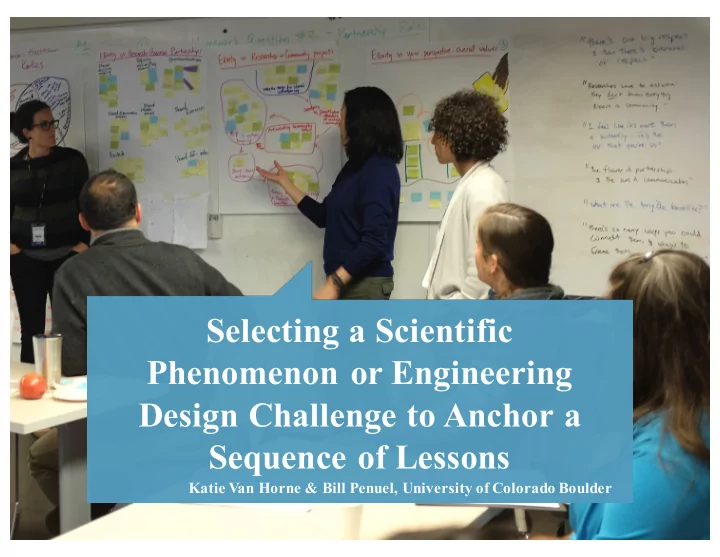

Selecting a Scientific Phenomenon or Engineering Design Challenge to Anchor a Sequence of Lessons Katie Van Horne & Bill Penuel, University of Colorado Boulder
Phenomena Are Everywhere, Which Are Useful for 3D Learning? + What approaches have you seen? + Which ones strike you as promising? As unsuccessful? + What distinguishes the promising from the unsuccessful strategies for identifying candidate phenomena? P + R
Denver iHub Partnership + Focused on curriculum development as a strategy + Use Reiser’s storyline approach to developing sequences of lessons + Unique addition: A process for selecting “anchors” that are both viable means to support student learning and that have strong connections to students’ interests and experiences + Engineering design challenges with a real-world connection (“citizen engineering”) + Science phenomena that are personally and community relevant P + R
Evidence of Relevance Engineering Design Challenge: Choose a species of tree to plant in your school yard 100% that will add to biodiversity and maximize beneficial services. (LS-HS-2-2.7) 67% 50% 29% 0% “Matters to Me” “Matters to the Community” P + R
Our Design Principles + Embody the principles of the Framework , especially: + Promoting 3-D science learning + Connecting to student interests and experiences + Promoting equity + Deeply address multiple standards + Next Generation Science Standards + Colorado Academic Standards + Connect teachers and learners to the community through technology and partnerships + Support student investigations that contribute to a larger citizen science or community initiative P + R
Our Four Phase Approach + Identifying and selecting good anchors for sequences of lessons takes time. + Expect false starts , but researching possibilities before designing assessments and lessons can improve efficiency by increasing the likelihood that phenomena and design challenges: + are “viable,” that is, have potential to support students’ three dimensional science learning + have necessary data that are accessible to students + connect to a broad range of students’ interests and experiences P + R
Phase/Meeting 1 Analyze (“Unpack”) the Focal DCIs Participants: Teachers and Teacher Leaders Do ahead of time: Decide on focal DCIs for lesson sequence P + R
Phase/Meeting 2 Brainstorm and Conduct Research on Candidate Phenomena/Challenges Participants: Teachers and Teacher Leaders, and if available, a local scientist or engineer Do ahead of time: Identify any local scientists or engineers to P participate + R
Criteria for a Good Anchor (1 of 2) A good anchor builds upon everyday or family experiences: Who they are, what they do, where they came from. A good anchor will require students to develop understanding of and apply multiple performance expectations. It is too complex for students to explain after a P single lesson. + R
Criteria for a Good Anchor (2 of 2) A good anchor is observable to students. A good anchor can be a case ( pine beetles’ destruction of lodgepole pine forests ) or something that is puzzling ( Why isn’t rainwater salty? ). A good anchor has relevant data, images, and text to engage students in the range of ideas students need to understand. P + R
Phase/Meeting 3 Engage Students in Prioritizing Candidate Phenomena/Challenges Participants: Teachers and their students Do ahead of time: Construct a survey of student interest in candidate phenomena and design challenges, ideally using an electronic survey tool that allows for immediate P + R aggregation of results.
Phase/Meeting 3 P + R
Phase/Meeting 4 Select Best Candidate Phenomena/Challenges Participants: Teachers and teacher leaders Do ahead of time: Aggregate results from student surveys P + R
Review Descriptions of Candidate Phenomena: HS Genetics + An example of current work of the team, in progress (Phase 2) + Evaluate against: + Opportunities to explore DCI + Availability of student-accessible data and scientific models + Likely interest to students (we’ll find this out, but where are likely connections) + What do you notice about what’s here? + What’s missing that would help you or others select phenomena? P + R
P + RESEARCH + PRACTICE COLLABORATORY R is made up of 4 collaborating laboratories …. working in partnership with…. with funding from… Funded by the National Science Foundation. Opinions expressed do not necessarily reflect the views of the Foundation.
Learn more at: researchandpractice.org
THANK YOU! P + R researchandpractice.org @RPCollaboratory Bill Penuel Katie Van Horne william.penuel@colorado.edu katie.vanhorne@colorado.edu @bpenuel, @learnDBIR @dizzvh
Recommend
More recommend